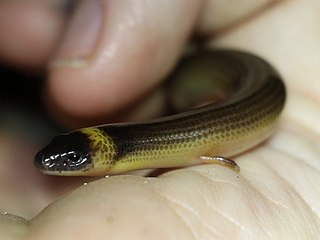
Anomalopus is a genus of worm-skinks, smallish smooth-scaled burrowing lizards in the family Scincidae. The genus is endemic to the eastern half of Australia. The genus belongs to a clade in the Sphenomorphus group which contains such genera as Ctenotus and the close relatives Eulamprus and Gnypetoscincus.

Eulamprus is a genus of lizards, commonly known as water skinks, in the subfamily Sphenomorphinae of the family Scincidae. The genus is native to Australia.
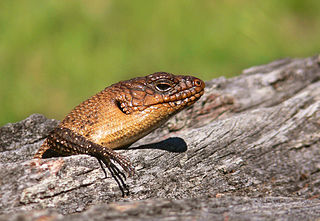
Cunningham's spiny-tailed skink, also known commonly as Cunningham's skink, is a species of large skink, a lizard in the family Scincidae. The species is native to southeastern Australia.
Anomalopus mackayi, commonly known as the five-clawed worm skink, long-legged worm skink, and Mackay's burrowing skink, is a species of smooth-scaled burrowing skink, a lizard in the family Scincidae. The species is endemic to eastern Australia.

The Blue Mountains water skink or Blue Mountains swamp-skink is a species of skink in the family Scincidae. An endangered species, it is found only in restricted parts of the mountains of southeastern Australia.

White's skink, also known commonly as White's rock skink, is a species of lizard in the skink family. It was first described in 1804 by French naturalist Bernard Germain de Lacépède. It is endemic to Australia.

Bougainville's skink is a species of skink, a lizard in the family Scincidae. This species is also commonly called the south-eastern slider and Bougainville's lerista.
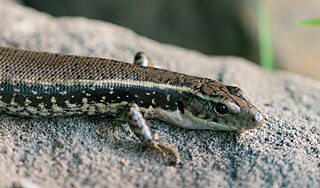
Eulamprus quoyii, more commonly known as the eastern water skink, eastern water-skink, or golden water skink, is a viviparous species of diurnal skink. Eulamprus quoyii belongs to the family Scincidae and is considered a common garden animal in Australia. The skink is endemic to Australia and found only along the east coast of the country. It makes its home in creekside habitats along the east coast of Australia and in urban garden areas with high amounts of moisture. The species can be identified by the twin, long yellow stripes that run along its body from the top of the eye, as well as by several more specific character derived states. The pale yellow dorsolateral stripes are most likely where its common name, the golden water skink, is derived. Like other ectotherms, the skink can often be seen basking in the sun on rocky outcroppings in order to regulate its body temperature. Its diet mainly consists of both aquatic and terrestrial insects, tadpoles and small amounts of plant matter. The skink both hunts for food and scavenges when necessary and is considered an opportunistic feeder. It is prey to larger lizards, snakes, cats and birds and so will often be seen moving quickly into hiding when other organisms are present.
Anomalopus swansoni, also known commonly as the punctate worm-skink or Swanson's burrowing skink, is a species of lizard in the family Scincidae. The species is endemic to Australia.

Ctenotus strauchii, also known commonly as the eastern barred wedge-snout ctenotus or Strauch's ctenotus, is a small species of lizard in the family Scincidae. The species is endemic to Australia and is found throughout semi-arid and arid regions in most of Australia's mainland states except Western Australia, although one record does exist for Western Australia in 1975.

The eastern mourning skink, also known commonly as Coventry's spinytail skink and the swamp skink, is a species of lizard in the family Scincidae. The species is endemic to Australia.
Lyon's snake-eyed skink is a species of lizard in the family Scincidae. The species is endemic to Queensland in Australia.
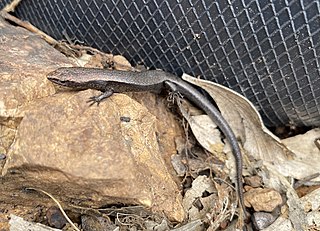
Carinascincus coventryi, also known commonly as Coventry's window-eyed skink and the southern forest cool-skink, is a species of lizard in the family Scincidae. The species is endemic to Australia.
Lampropholis caligula, also known commonly as the montane sunskink or the montane sun skink, is a species of lizard in the family Scincidae. The species is endemic to New South Wales in Australia.

Lampropholis coggeri, also known commonly as the northern sun skink and the rainforest sunskink, is a species of lizard in the family Scincidae. The species is endemic to Queensland in Australia.
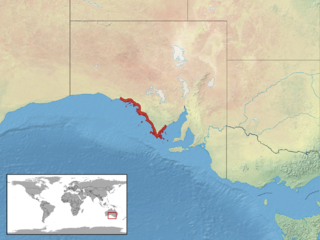
Pseudemoia baudini, also known commonly as Baudin's skink, Baudin's window-eyed skink, and the Bight Coast skink, is a species of lizard in the family Scincidae. The species is endemic to Australia.

Pseudemoia pagenstecheri, also known commonly as the southern grass tussock skink or the southern tussock grass skink, is a species of lizard in the family Scincidae. The species is endemic to Australia.
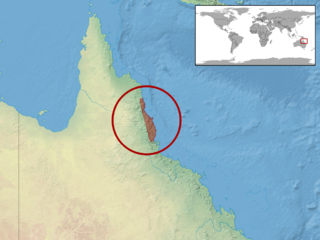
Saproscincus czechurai, also known commonly as Czechura's litter-skink, Czechura's skink, and the wedge-snouted shadeskink, is a species of lizard in the family Scincidae. The species is endemic to Queensland in Australia.
Concinnia frerei, also known commonly as the stout bar-sided skink or the stout barsided skink, is a species of lizard in the family Scincidae. The species is endemic to Queensland in Australia.

The warm-temperate water-skink, Heatwole's water skink or yellow-bellied water skink is a species of skink found in New South Wales and Victoria in Australia. It lives in rocky habitats, preferring those near water such as bogs, swamps, creek and river margins. It can also be found on dry and wet forests, open woodlands and heathlands, commonly seen basking on waterside logs and rocks.
















